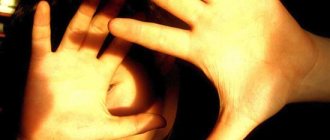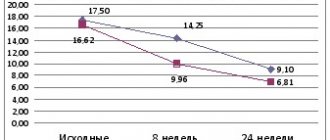Kinds
Depending on the time of appearance:
- acquired nystagmus resulting from such reasons as vision loss, toxic poisoning, central nervous system pathology;
- congenital nystagmus, accompanied by mild symptoms with abnormal head position. Nystagmus in children occurs after 2–3 months of life and persists throughout the entire life cycle.
Depending on the reasons, there are:
- pathological nystagmus, as a result of diseases of the vestibular apparatus or the brain;
- physiological nystagmus, in turn divided into vestibular nystagmus, associated with an effect on the inner part of the ear, and optokinetic, which occurs when objects flash very quickly before the eyes (for example, watching objects from a car or train window). Only this type is the norm and is inherent in all people.
Depending on the direction:
- rotational, accompanied by synchronous circular eye movements;
- horizontal nystagmus, with horizontal oscillatory movements. There is left-sided and right-sided nystagmus.
- vertical nystagmus - with movements of an oscillatory nature in the vertical.
There is also professional nystagmus, which occurs as a result of many years of work in a mine. Negative factors affecting a person are quite strong eye strain during work, poor lighting and ventilation of mines, possible intoxication with gases - carbon monoxide, methane.
Depending on the strength of expression:
- nystagmus of the first degree, when there are no symptoms at rest, occurs in a rapid phase when the eye is moved to its extreme position;
- nystagmus of the second degree, occurring in the central position of the eyeball;
- nystagmus of the third degree, occurring in the slow phase when the eye is moved to the side.
Characteristics of the disease nystagmus
Nystagmus, what is it? The disease nystagmus is characterized by involuntary oscillations of the eyes, which have a pendulum character. The causes of the disease are physiological and pathological changes.
Physiological nystagmus is oscillatory eye movements when a person moves in space. In this case, this is considered an element of the norm and is responsible for maintaining normal vision.
The development of nystagmus is preceded by several factors. A common cause of the development of the disease is the manifestation of the disease from birth, or its acquisition throughout life, which can be associated with various diseases (loss of transparency of the optical spheres of the eye, albinism, degenerative changes in the retina, and so on). These diseases provoke disturbances in the mechanism of visual fixation, which provokes nystagmus.
Causes
Almost always, spontaneous nystagmus develops as a result of diseases of different areas of the brain responsible for eye movement and coordination (tumors, cerebrovascular accident). Malformations of the skull, traumatic brain injuries, and all kinds of eye diseases (optic atrophy, retinal dystrophy, albinism) also lead to the disease. It is also caused by poisoning with potent medications, in particular sleeping pills or narcotic substances. There may be a hereditary factor causing a congenital form of nystagmus.
Symptoms of the disease
Ocular nystagmus develops when there is a certain eye disease; its symptoms are similar to those of the underlying disease. The patient experiences sensitivity to light, frequent dizziness, and poor vision. Often patients complain of a blurry image before their eyes, or its fluctuation and trembling.
During examination, the ophthalmologist notes a significant fluctuation of the eyeball, which can have a variety of directions. Eye movement can occur either spontaneously or due to certain provoking factors.
Depending on the direction there are:
- Horizontal view;
- Vertical.
The right eye moves to the right side faster than to the left, this phenomenon is jerky. Sometimes there is a mixed type, in which when a person looks straight ahead there is a pendulum movement, and in one direction there is a jerky movement.
Symptoms in children are divided into several types.
After the first month of life, the child’s gaze must focus. If this does not happen, then suspicion falls on the existence of nystagmus in the eye. Sometimes, this phenomenon is congenital in nature, and is formed during intrauterine development. This deviation has the following features:
- Formed in the second month and occurs throughout life;
- Pathology is absent when the eyes are closed;
- The nature of the direction is horizontal and jerky.
In some directions the symptom does not manifest itself in any way.
Spasm of a sternocleidomatous nature. It appears between the ages of three months and one year. If the cause cannot be determined, then sometimes it completely goes away by the age of three. Sometimes the reason lies in the development of a pathological tumor. Low-amplitude nystagmus is sometimes accompanied by head nodding.
Latent nystagmus. Occurs in the presence of strabismus not accompanied by various types of paresis. A characteristic of this condition is that nystagmus does not appear when the eyes are open, and occurs only when the lighting deteriorates. This disease can occur in people with albinism, a condition where there is no pigment in the iris.
Symptoms
The manifestations of this pathological condition largely depend on what mechanisms underlie its formation. When nystagmus develops, the symptoms of this disorder are not always as obvious as they might seem.
Oscillatory movements are often quite weakly expressed and are noted only under certain circumstances. This symptom of nystagmus can also manifest itself very intensely, significantly affecting a person’s ability to focus normally and see objects.
In addition to the characteristic oscillatory movements, there may be a number of other signs that usually accompany this pathological condition.
People with this disorder often complain of:
- decreased vision;
- increased photosensitivity;
- shaking or blurriness of the image;
- feeling of instability;
- attacks of dizziness.
Due to the inability to fix the gaze for a long time, nystagmus of the eyeball in some cases provokes nausea. This type of disorder can be accompanied by attacks of severe headaches, hearing loss, progressive strabismus, impaired coordination of movements, decreased muscle tone and unsteadiness of gait.
Diagnostic measures of nystagmus
Almost any doctor, after examining a patient, can diagnose eye nystagmus, due to the presence of chaotic movements of the eyeball. To find out the cause, you will need a comprehensive diagnosis. The doctor will examine visual acuity, the appearance of the retina and fundus of the eye, and will also check the correct functioning of the oculomotor system. Next, the patient will be referred for a consultation with a neurologist to undergo procedures: EEG, Echo-EG.
After successful diagnostic tests and results, the doctor prescribes therapeutic treatment. The first thing that needs to be done is to eliminate the underlying disease that triggered the development of nystagmus. Vasodilating eye drops are indicated for use, as well as vitamins that are necessary to nourish the eye and retina.
Sometimes surgical intervention is indicated in which weakened muscles are strengthened, or very strong ones are weakened. This procedure allows you to reduce the amplitude of oscillatory movements of the eyeballs. A cure is possible, but it is a long and difficult process.
Diagnostics
An objective examination of the patient is sufficient to make a diagnosis. During an external examination, it is possible to visualize involuntary eye movements. To determine the direction of nystagmus, the patient is asked to focus his gaze on a pen or a special pointer. The ophthalmologist moves the instrument up, down, right and left. The shape of the lesion is determined in the direction of the fast component. To study the etiology of the disease and select further management tactics, the following is used:
- Microperimetry
. The technique allows you to determine the point of fixation on the inner shell of the eyeball, record the parameters of optical nystagmus and study the sensitivity of the retina. The method makes it possible to monitor the condition of patients to assess the effectiveness of treatment measures. - Electronystagmography (ENG)
. The study is based on recording biopotentials that arise between the cornea and retina. In individuals with involuntary eye movements, the electrical axis shifts, which is accompanied by an increase in the difference in corneoretinal biopotential to 100-300 μV. - Visometry
. Patients experience decreased visual acuity due to functional disorders of the visual analyzer. - Refractometry
. Diagnostics are carried out to establish the type of clinical refraction. Patients with nystagmus often experience impaired ability to accommodate, myopia. Hypermetropia is rarely diagnosed. - CT scan of the brain.
Computed tomography is used to identify pathological neoplasms or signs of dislocation of brain structures, which may underlie the occurrence of pathology.
Main types of nystagmus
Depending on the time of appearance:
- Congenital in nature, some changes in the functioning of the eyes appear for some time after birth and persist throughout life;
- Acquired - occurs when there is a malfunction of the central and peripheral nervous system. It occurs regardless of the age category of people. It can start in both a child and an elderly person.
Congenital nystagmus is divided into the following types:
- Optical - malfunctions in the functioning of the visual apparatus, which can occur as early as 2-3 months of life;
- Latent - most often occurs when a child has strabismus. It is detected only when one eye is closed;
- A spasm of a sternocleidomastoid nature develops from three to one and a half years quite rarely. Very often accompanied by a crooked neck and constant head nodding, which absolutely do not coincide with eye twitching.
Acquired, in turn, is divided into:
- Central in nature, the cause is disturbances in the functioning of the central nervous system. Namely, stroke, various benign and malignant tumors. Symptoms can be varied, starting with constant dizziness and being constant or periodic;
- Peripheral in nature - malfunctions of the vestibular analyzer. The cause is an infectious lesion of the labyrinth, or the parotid-cochlear nerve. Often accompanied by minor impairments in coordination and hearing.
There are types of nystagmus that can only be determined by examination by specialists. The following are distinguished:
- Converting;
- Periodically alternating;
- Vertical;
- Refractory.
Some types indicate a specific location, while others indicate certain ailments.
Physiological nystagmus manifests itself in a healthy person and is considered normal; it occurs when external factors influence the body.
The forms of physiological nystagmus are as follows:
- The setting form has a low frequency and can be seen when looking away;
- Vestibular form - revealed when the eyes rotate;
- Optokinetic - when the eyes move slowly, everything is fine, but when they accelerate, it is jerky.
When diagnosing various types of pathologies, the necessary studies are used.
The pathological nature of the disease has the following forms:
- The ocular shape can be either congenital or acquired;
- Professional occurs among those people whose work is associated with hazardous industries and with constant concentration of attention;
- Labyrinthine, develops when the ear apparatus is damaged. It lasts for several days or weeks and goes away quickly;
- Neurogenic develops when the vestibular reflex responsible for oculomovement is disrupted.
Treatment of nystagmus
The pathological form is practically untreatable. Initially, it is necessary to get rid of the disease that provoked the development of this condition. Farsightedness is corrected with glasses. Vitamin complexes and drugs with a vasodilating effect will help increase the replenishment of the eye and retina. Advanced cases are treated only surgically. Strong muscles are weakened, and weak ones are tightened. At the same time, the head takes the correct position, vision improves.
Treatment of this disease is a long and difficult process. In addition to modern treatment methods, doctors recommend wearing glasses and contacts. The lenses are slightly more expensive than regular glasses, but the lenses always remain in place when the eyes move.
Preventive measures for the treatment of nystagmus
Taking any medications must be treated with great caution. Start taking any medications only after being prescribed by a doctor. A pregnant woman must do her best to prevent intrauterine retention. Try to protect yourself as much as possible from infectious diseases. During pregnancy, do not have contact with small children, especially those who attend kindergartens. Visit an ophthalmologist every six months as a preventative measure. Everyone knows that it is easier and faster to cure a disease at an early stage than in an advanced state.
Horizontal nystagmus Causes of nystagmus in a newborn baby Possible reasons for the appearance of nystagmus How to get rid of bags under the eyes?
Folk remedies
Classical medicine does not reject the treatment of nystagmus with folk remedies. But it must be combined with drug treatment.
The following folk recipes are widely in demand:
- Parsley juice. It should be drunk before meals at least 3 times during the day, freshly squeezed.
- Dill. You need to infuse the dill seeds for 50-60 minutes in a dark place. Drink half a cup of infusion every hour all day.
- Caraway. Pour boiling water over a tablespoon of spice and leave for an hour. Take ½ cup infusion 2 times a day.
But it is necessary to start treatment according to traditional recipes after consultation with an ophthalmologist.












